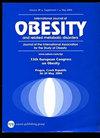在针对肥胖儿童的多学科生活方式干预中加入高强度间歇训练的可行性和有效性--随机对照试验。
IF 4.2
2区 医学
Q1 ENDOCRINOLOGY & METABOLISM
引用次数: 0
摘要
背景:在丹麦,针对肥胖儿童的多学科生活方式干预通常包括有关体育锻炼的建议,但没有结构化的锻炼计划。我们假设,在多学科生活方式干预中加入高强度间歇训练(HIIT)将改善体重指数 z 值(主要结果)、腰围、血压和健康相关生活质量(HRQOL):这项随机对照试验包括 173 名肥胖儿童和青少年。参与者被分配接受为期 12 个月的生活方式干预(83 人),或接受为期 12 个月的生活方式干预,同时进行为期 12 周的 HIIT 训练(90 人)。HIIT每周进行三次,包括强度大于最大心率85%的活动:为期 3 个月的 HIIT 干预的参加率为 68.0 ± 23.2%。在三个月(7.8% 对 20.5%)和 12 个月(26.5% 对 48.2%)时,HIIT 的辍学率低于对照组。HIIT 和对照组在 3 个月和 12 个月时的 BMI z-score 变化没有差异(平均差 (MD): 0.01,95% 置信区间 (CI): -0.09; 0.12,P = 0.82)(MD: 0.06,CI: -0.07; 0.19,P = 0.34)。在整个随机过程中,BMI z-score降低了0.11(CI:0.17;0.06,P 结论:BMI z-score降低了0.11(CI:0.17;0.06):增加为期 12 周的 HIIT 训练并不能进一步增强为期 12 个月的生活方式干预对 BMI z 分数的积极影响。增加 HIIT 可改善 3 个月后的 HRQOL,但会降低 12 个月后的 HRQOL。在社区环境中实施 HIIT 是可行的,而且对坚持生活方式干预有积极作用。本文章由计算机程序翻译,如有差异,请以英文原文为准。

Feasibility and efficacy of adding high-intensity interval training to a multidisciplinary lifestyle intervention in children with obesity—a randomized controlled trial
Multidisciplinary lifestyle interventions for children with obesity in Denmark often include recommendations regarding physical activity, but no structured exercise program. We hypothesized that adding high-intensity interval training (HIIT) to a multidisciplinary lifestyle intervention would improve BMI z-score (primary outcome), waist circumference, blood pressure, and health-related quality of life (HRQOL). This randomized controlled trial included 173 children and adolescents with obesity. Participants were allocated to 12-months lifestyle intervention (N = 83), or 12-month lifestyle intervention accompanied by a 12-week HIIT program (N = 90). HIIT consisted of three weekly sessions and included activities eliciting intensities >85% of maximal heart rate. Attendance rate for the 3-months HIIT intervention was 68.0 ± 23.2%. Dropout was lower in HIIT compared to control at three months (7.8% vs. 20.5%) and 12 months (26.5% vs 48.2%). Changes in BMI z-score did not differ between HIIT and control at 3 months (Mean Difference (MD): 0.01, 95% confidence interval (CI): −0.09; 0.12, P = 0.82) or 12 months (MD: 0.06, CI: −0.07;0.19, P = 0.34). Across randomization, BMI z-score was reduced by 0.11 (CI: 0.17; 0.06, P < 0.01) at 3 months and 0.20 (CI: 0.26;0.14, P < 0.01) at 12 months. At 3 months, HIIT experienced a greater increase in HRQOL of 2.73 (CI: 0.01;5.44, P = 0.05) in PedsQL Child total-score and 3.85 (CI: 0.96; 6.74, P < 0.01) in psychosocial health-score compared to control. At 12 months, PedsQL Child physical-score was reduced by 6.89 (CI: 10.97; 2.83, P < 0.01) in HIIT compared to control. No group differences or changes over time were found for waist circumference or blood pressure. Adding a 12-week HIIT program did not further augment the positive effects of a 12-month lifestyle intervention on BMI z-score. Adding HIIT improved HRQOL after 3 months, but reduced HRQOL at 12 months. Implementation of HIIT in community-based settings was feasible and showed positive effects on adherence to the lifestyle intervention.
求助全文
通过发布文献求助,成功后即可免费获取论文全文。
去求助
来源期刊

International Journal of Obesity
医学-内分泌学与代谢
CiteScore
10.00
自引率
2.00%
发文量
221
审稿时长
3 months
期刊介绍:
The International Journal of Obesity is a multi-disciplinary forum for research describing basic, clinical and applied studies in biochemistry, physiology, genetics and nutrition, molecular, metabolic, psychological and epidemiological aspects of obesity and related disorders.
We publish a range of content types including original research articles, technical reports, reviews, correspondence and brief communications that elaborate on significant advances in the field and cover topical issues.
 求助内容:
求助内容: 应助结果提醒方式:
应助结果提醒方式:


